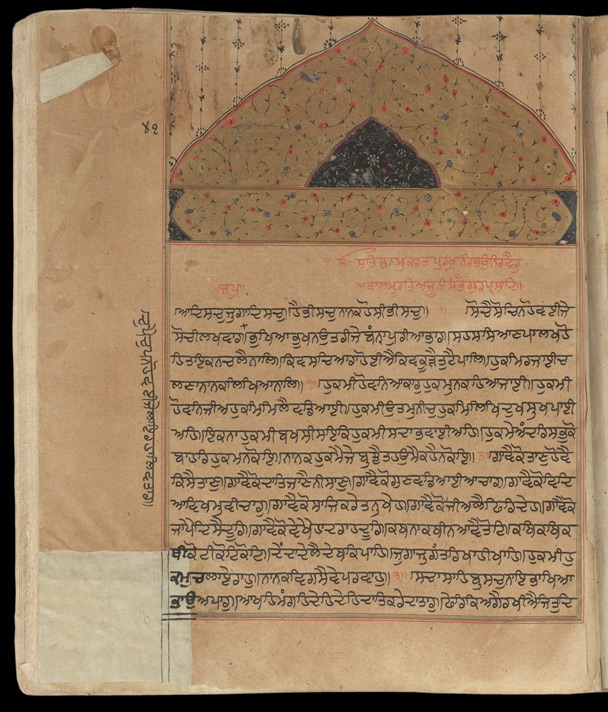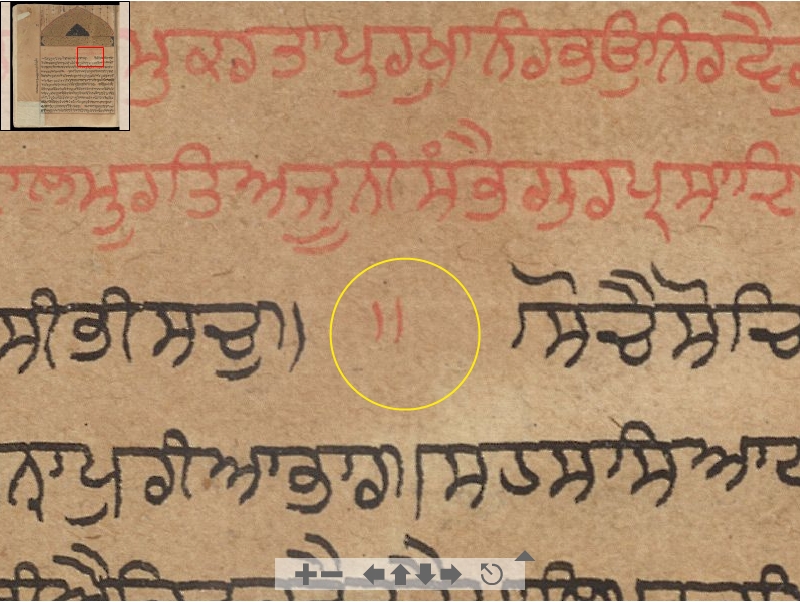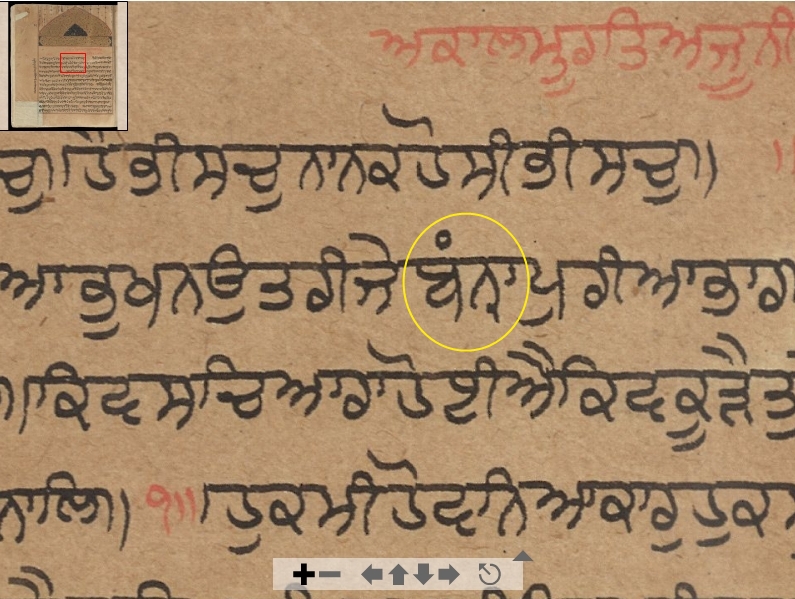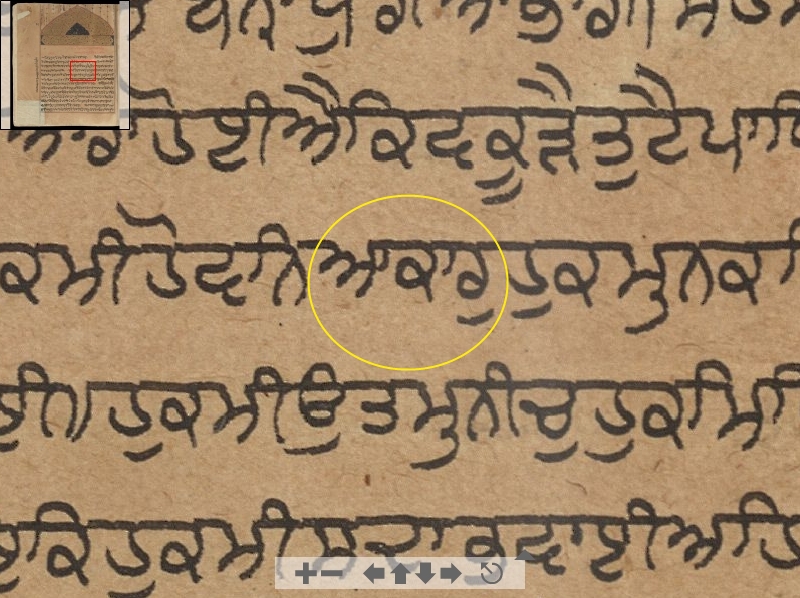Guru Granth Sahib 1660

click on the image to enlarge
British Library Manuscript 17th Century
The adjacent photo shows the beginning of a 1660-75 copy of the holy text of the Sikhs and their guiding Guru (spiritual Guide or teacher), the Guru Granth Sahib that has been preserved at the British Library for over 125 years.
The Guru Granth Sahib or Adi Sri Granth Sahib Ji, is more than just a scripture of the Sikhs. The Sikhs treat this Granth (holy book) as a living Guru. The holy text spans 1430 pages and contains the actual words spoken by the founders of the Sikh religion (the Ten Gurus of Sikhism) and the words of various other Saints from other religions including Hinduism and Islam.
Guru Granth Sahib was given the Guruship by the last of the living Sikh Masters, Guru Gobind Singh Ji in 1708. Guru Gobind Singh said before his demise that the Sikhs were to treat the Granth Sahib as their next Guru. Guru Ji said – “Sab Sikhan ko hokam hai Guru Manyo Granth” meaning “All Sikhs are commanded to take the Granth as Guru” So today if asked, the Sikhs will tell you that they have a total of 11 Gurus. ( 10 in human form and the SGGS).
The copy of the holy Granth at the British Library is one of very few copies of this very important text of the Sikhs still left in the world and still available from that period. As the caption at the museum site reads:
This is the oldest known manuscript copy outside India of a substantial part of the Sikh scripture, the 'Guru Granth Sahib' or 'Adi Granth'. The original 'Adi Granth', containing verses by the founder of Sikhism, Guru Nanak, and other Sikh Gurus and saints, was compiled in 1603-4 by the fifth Sikh Guru Arjun. This manuscript dates in part from the middle of the 17th century (c.1660-75), and is therefore one of the twenty oldest known copies in existence. It was purchased by the British Museum in 1884 from the Reverend A Fischer, who had been the principal of a missionary school in Amritsar, Panjab.
Comparison of text
The same text is printed below in similar format:
- ੴ ਸਤਿ ਨਾਮ ਕਰਤਾ ਪਰਖ ਨਿਰਭਉ ਨਿਰਵੈਰ line 1
- ਅਕਾਲ ਮੂਰਤਿ ਅਜੂਨੀ ਸੈਭੰ ਗਰ ਪਰਸਾਦਿ ॥ line 2
- ॥ ਜਪ ॥ line 3
ਆਦਿ ਸਚ ਜਗਾਦਿ ਸਚ ॥ ਹੈ ਭੀ ਸਚ ਨਾਨਕ ਹੋਸੀ ਭੀ ਸਚ ॥੧॥ ਸੋਚੈ ਸੋਚਿ ਨ ਹੋਵਈ ਜੇ line 4
ਸੋਚੀ ਲਖ ਵਾਰ ॥ +ਚਪੈ ਚਪ ਨ ਹੋਵਈ ਜੇ ਲਾਇ ਰਹਾ ਲਿਵ ਤਾਰ ॥ ਭਖਿਆ ਭਖ ਨ ਉਤਰੀ ਜੇ ਬੰਨਾ ਪਰੀਆ ਭਾਰ ॥ ਸਹਸ ਸਿਆਣਪਾ ਲਖ ਹੋ line 5
ਹਿ ਤ ਇਕ ਨ ਚਲੈ ਨਾਲਿ ॥ ਕਿਵ ਸਚਿਆਰਾ ਹੋਈਝ ਕਿਵ ਕੂੜੈ ਤਟੈ ਪਾਲਿ ॥ ਹਕਮਿ ਰਜਾਈ ਚ line 6
ਲਣਾ ਨਾਨਕ ਲਿਖਿਆ ਨਾਲਿ ॥੧॥ ਹਕਮੀ ਹੋਵਨਿ ਆਕਾਰ ਹਕਮ ਨ ਕਹਿਆ ਜਾਈ ॥ ਹਕਮੀ line 7
ਹੋਵਨਿ ਜੀਅ ਹਕਮਿ ਮਿਲੈ ਵਡਿਆਈ ॥ ਹਕਮੀ ਉਤਮ ਨੀਚ ਹਕਮਿ ਲਿਖਿ ਦਖ ਸਖ ਪਾਈ line 8
ਅਹਿ ॥ ਇਕਨਾ ਹਕਮੀ ਬਖਸੀਸ ਇਕਿ ਹਕਮੀ ਸਦਾ ਭਵਾਈਅਹਿ ॥ ਹਕਮੈ ਅੰਦਰਿ ਸਭ ਕੋ line 9
ਬਾਹਰਿ ਹਕਮ ਨ ਕੋਇ ॥ ਨਾਨਕ ਹਕਮੈ ਜੇ ਬਝੈ ਤ ਹਉਮੈ ਕਹੈ ਨ ਕੋਇ ॥੨॥ ਗਾਵੈ ਕੋ ਤਾਣ ਹੋਵੈ line 10
ਕਿਸੈ ਤਾਣ ॥ ਗਾਵੈ ਕੋ ਦਾਤਿ ਜਾਣੈ ਨੀਸਾਣ ॥ ਗਾਵੈ ਕੋ ਗਣ ਵਡਿਆਈਆ ਚਾਰ ॥ ਗਾਵੈ ਕੋ ਵਿਦਿ line 11
ਆ ਵਿਖਮ ਵੀਚਾਰ ॥ ਗਾਵੈ ਕੋ ਸਾਜਿ ਕਰੇ ਤਨ ਖੇਹ ॥ ਗਾਵੈ ਕੋ ਜੀਅ ਲੈ ਫਿਰਿ ਦੇਹ ॥ ਗਾਵੈ ਕੋ line 12
ਜਾਪੈ ਦਿਸੈ ਦੂਰਿ ॥ (end of page 1 of modern bir)ਗਾਵੈ ਕੋ ਵੇਖੈ ਹਾਦਰਾ ਹਦੂਰਿ ॥ ਕਥਨਾ ਕਥੀ ਨ ਆਵੈ ਤੋਟਿ ॥ ਕਥਿ ਕਥਿ ਕ line 13
ਥੀ ਕੋਟੀ ਕੋਟਿ ਕੋਟਿ ॥ ਦੇਦਾ ਦੇ ਲੈਦੇ ਥਕਿ ਪਾਹਿ ॥ ਜਗਾ ਜਗੰਤਰਿ ਖਾਹੀ ਖਾਹਿ ॥ ਹਕਮੀ ਹ line 14
ਕਮ ਚਲਾਝ ਰਾਹ ॥ ਨਾਨਕ ਵਿਗਸੈ ਵੇਪਰਵਾਹ ॥੩॥ ਸਾਚਾ ਸਾਹਿਬ ਸਾਚ ਨਾਇ ਭਾਖਿਆ line 15
ਭਾਉ ਅਪਾਰ ॥ ਆਖਹਿ ਮੰਗਹਿ ਦੇਹਿ ਦੇਹਿ ਦਾਤਿ ਕਰੇ ਦਾਤਾਰ ॥ ਫੇਰਿ ਕਿ ਅਗੈ ਰਖੀਝ ਜਿਤ ਦਿ line 16
Text in green is on the side as the writer appears to have made an error! A small "+" (plus sign) in the original text tells us where this green text is to be inserted
Interesting Differences
- 1. The first ॥੧॥ in the modern bir is missing in the older text
- 2. The line 5, the word "banna" is written as ਬੰਨਾ which is shown in green in the tuk - ਭਖਿਆ ਭਖ ਨ ਉਤਰੀ ਜੇ ਬੰਨਾ ਪਰੀਆ ਭਾਰ ॥ - is written as ਬੰਨਰਾ in the old text and as ਬੰਨਾ in the modern bir. The letter ਨ in the word ਬੰਨਾ has a modifier at its foot! See the second photo in the gallery below:
- 3. In line 7, the modern text shows the word "akar" written as ਆਕਾਰ while the third photo below shows that in the ancient text this word was written as ਆਕਾਰ.
Is this an error made by the scribe or is there an error in the modern bir?
Gallery
British Library - images from this link
- 17th Century copy of Guru Granth Sahib at the British Library
The first ॥੧॥ in the modern bir is missing in the older text



